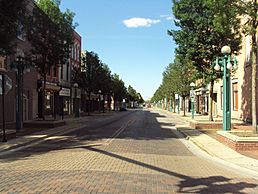Downtown Adrian Commercial Historic District facts for kids
Quick facts for kids |
|
|
Downtown Adrian
Commercial Historic District |
|

Looking north along Main Street (M-52)
|
|
| Location | Adrian, Michigan |
|---|---|
| Architectural style | Federal, Greek Revival, and Late Victorian |
| NRHP reference No. | 86000803 |
| Added to NRHP | April 17, 1986 |
The Downtown Adrian Commercial Historic District is a special area in Adrian, Michigan. It's like a time capsule of the city's main downtown area. This district was officially recognized as a Michigan Historic Site and added to the National Register of Historic Places on April 17, 1986.
The district is located between several streets. On the north, it's near Toledo Street. To the east, you'll find North Broad Street. South of it is East Church Street. On the west, it's bordered by North Winter Street (M-52), West Maumee Street, and the River Raisin. Most of this historic area is close to the US-223 Business Route.
History of Downtown Adrian
Adrian was first settled in 1826 by a person named Addison J. Comstock. He built some cabins there. Comstock also built a sawmill, which helped the area grow. In 1828, he planned out the first part of the city. Most of this original plan is still part of the historic district today.
At first, both homes and businesses were built in the area. The very first store, a dry goods shop, opened in 1829. As Adrian grew, older wooden buildings were replaced by new commercial ones. In 1838, Adrian became the main city for the county. This brought more legal and financial businesses to the downtown area. Many banks also opened in the mid-1800s.
By the late 1800s, downtown Adrian was at its busiest. A new courthouse was built in 1884, just outside the district. Adrian became a central place for farmers in the area to buy supplies. By 1900, the downtown area's growth slowed down. Because of this, the district hasn't changed much since then. Even though some storefronts have been updated, and a few buildings were removed or added, downtown Adrian still looks a lot like it did over a century ago.
What You'll See in the District
The Downtown Adrian Commercial Historic District has 102 buildings. Out of these, 84 are important because they show the historical character of the area. The buildings here display different styles of architecture. You can see Federal, Greek Revival, and Late Victorian designs.
The oldest buildings in the district were built around 1865. Most of the buildings were constructed between 1865 and 1920. Many are two or three stories tall and were used for businesses. However, there are also some churches and government buildings. Other important places include the Adrian Union Hall-Croswell Opera House and Clark Memorial Hall. These two buildings are so important that they are listed on the National Register of Historic Places by themselves.
Many buildings in the district are in the Italianate style. A great example is the Clark Memorial Hall. It has cool designs made from limestone and metal. You can also find older styles like the three-story brick Federal style Lathrop Block at 128 E. Maumee. Greek Revival buildings are also present. These include the large three-story Underwood Block at 101 E. Maumee. Two old churches, the 1837 First Baptist Church and the 1842 First United Presbyterian Church, also show this style.
Some newer buildings from the early 1900s are also part of the district. The 1905 YMCA building at 146-150 S. Main mixes Richardsonian and Classical styles. The 1925 Tudor Adrian Armory is at 230 W. Maumee. And the 1924 Neoclassical Masonic Temple is located at 160 E. Maumee.
Images for kids




